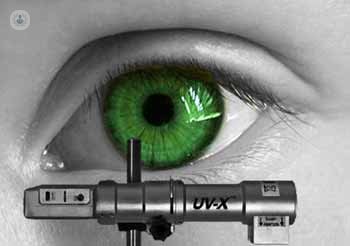Corneal Cross-Linking alternatively corneal transplantation
Written by:
What is the technical Corneal Cross-Linking?
 The technique Corneal cross-linking is Riboflavin instilling eye drops to the cornea and then applying a UVA. This union, according to specialists in Ophthalmology , causes a reaction that produces the corneal collagen strengthening and, in this way, you can stop the progression of keratoconus.
The technique Corneal cross-linking is Riboflavin instilling eye drops to the cornea and then applying a UVA. This union, according to specialists in Ophthalmology , causes a reaction that produces the corneal collagen strengthening and, in this way, you can stop the progression of keratoconus.
Advantages of Corneal Cross-Linking
The technique of Cross-Linking to delay or avoid a corneal transplant to restore corneal stiffness. It is an excellent therapeutic method with excellent results that can be done in isolation in early grades of keratoconus, or in combination with intracorneal rings and / or phakic lenses in later grades.
Results of Corneal Cross-Linking are better than those obtained with corneal transplant, restoring the vision is much faster, and not existeriesgo rejection.
The most advanced and effective technique of the moment is the Cross-Linking Transepithelial accelerated iontophoresis. By not removing the epithelium or outer layer of the cornea, postoperative discomfort are minimal, and being accelerated procedure takes less than 15 minutes per eye.
As Corneal Cross-Linking technique is a simple, non-invasive and is performed in an outpatient surgery without income-not involved ningúnriesgo.
Patient preparation for technical Corneal Cross-Linking
Before undergoing the Corneal Cross-Linking technique, the patient must make a proper pre lid hygiene and antibiotic eye drops applied three days before treatment. In addition, you should fast 6 hours prior to the procedure.
What requires monitoring technique Corneal Cross-Linking?
After undergoing technique Corneal Cross-Linking the patient must wear a bandage contact lens during the first 48-72 hours. In addition it also has to be treated with an oral anti-inflammatory and cycloplegic eye drops to prevent any discomfort or pain. During this time, due to dilataciónde pupil, it will be normal blurry.
Then, for 20 days, the patient should antibiotics and anti-inflammatory eye drops and artificial tears applied for 3 months. Also avoid make-up and input of non-sterile water for the first 15 days.


